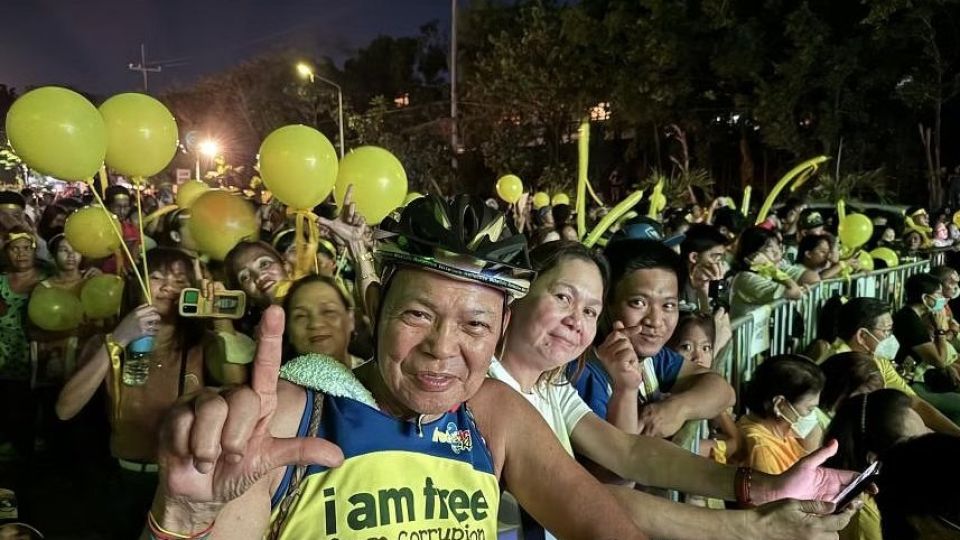February 26, 2024
MANILA – The Philippines’ opposition movement gathered by the thousands across cities on Feb 25 to protest against President Ferdinand Marcos Jr’s plans to amend the Constitution, using the 38th anniversary celebrations of the bloodless revolt that ousted his father in 1986 to rally support.
The charter change, known colloquially as cha-cha, has been framed as economic reforms, but critics warn that Marcos-allied lawmakers could also extend the president’s time in office, which is restricted to a six-year term under the 1987 Constitution.
In Quezon City near the capital Manila, activists decked in yellow, white and black held a protest along Epifanio delos Santos Avenue (Edsa), where thousands of Filipinos marched in 1986 to protest against Mr Marcos Sr’s 21-year rule that was plagued by rampant corruption, killings, disappearances and media oppression.
People came bearing signs that read, “Buhay ang Edsa! Cancel cha-cha!” (The spirit of the Edsa revolution lives! Cancel charter change!) and “Cha-cha ng elitista, pahirap sa masa!” (Charter change of the elitists only brings suffering to the masses!).
On the evening of Feb 25, organisers also held a free concert that included a countdown to mark 9.05pm, which was around the same time that the Marcoses fled the presidential palace to Hawaii on Feb 25, 1986, during the revolt known as People Power.
Other gatherings and caravans were held in parts of central and southern Philippines to commemorate the historic event.
Some churches and schools also hosted screenings of documentaries and art exhibits depicting the abuses that occurred during the Marcos dictatorship.
President Marcos Jr, the strongman’s only and namesake son, appointed some of his relatives to plum government posts when he came to power.
Mr Kiko Aquino Dee, co-convenor of the Buhay ang Edsa Campaign Network that spearheaded the events, said it was only natural for the opposition to use the People Power anniversary as a vehicle to oppose charter change.
He is the grandson of Philippine democracy icons Benigno “Ninoy” Aquino Jr and Corazon Aquino. The 1983 assassination of opposition senator Ninoy is widely considered a key event that pushed Filipinos to unseat Mr Marcos Sr.
They then installed Mr Ninoy’s widow Corazon as the 11th Philippine president. She oversaw the drafting of the current Constitution that was designed to prevent another dictatorship.
Mr Dee said the opposition was compelled to act after Mr Marcos first removed the People Power anniversary from the list of national holidays in 2024. The President said this was done because the event fell on a Sunday.
Then in January 2024, Mr Marcos’ allies started holding hearings on resolutions seeking to amend the Constitution.
“It kind of just heated up perfectly for us to express our resistance,” Mr Dee said.
There have been other attempts in the post-Marcos dictatorship years to change the Constitution. Proposals often included the extension of officials’ terms of office or a complete change of the system of government. These efforts all failed because the Senate blocked them.
Proponents of the changes say the 1987 Constitution has failed to give Filipinos the economic progress that the revolution had promised them.
Marcos-allied legislators, who dominate the House, want to lift the constitutional restrictions on foreign ownership of public utilities, educational institutions and advertising firms to spur economic development.
But this could just be a “Trojan horse” to win the people’s support without informing them of the true intentions of the constitutional changes, said ISEAS – Yusof Ishak Institute fellow Aries Arugay.
He said that once the charter change process is started, nothing would stop lawmakers from touching other parts of the charter.
“If you look at the Bills that had been filed last year on charter change, they don’t just involve economic provisions. They are proposing to allow re-election for the president, extension of term limits. That could be their underlying agenda,” said Dr Arugay.
Constitutional changes require approval from three-quarters of the House and the Senate collectively.
But the rules are silent about whether both Chambers must vote jointly or separately.
The Marcos government is now proposing that the two bodies vote together, which means the 24 senators would be easily outnumbered by the 316 lawmakers, roughly 95 per cent of whom are allied to the current administration.
Mr Marcos, however, has assured the public that his administration would support only an economic charter change.
He said he is not closed to the idea of amending political provisions, but would rather leave discussion on term limits to a later time.
“For the present day, my concern is the economic provisions, and I don’t want to confuse the issue any longer,” he said in an interview with local television network GMA News on Jan 23.

